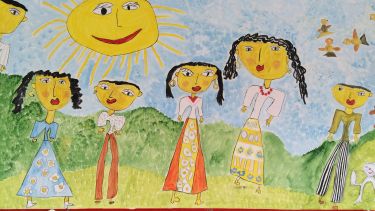Nurturing Slovak Roma children at secondary school: a longitudinal study
Since Slovakia joined the EU in May 2004, there has been a Slovak Roma community, now some 6000 strong, located in the area of Page Hall in Sheffield.

This new community has enriched the already super-diverse city of Sheffield, but it is fair to say that the Roma children have faced various issues in relation to their schooling, particularly in terms of their lack of English, effectively for some a third language, and often truncated educational experiences.
Dr Mark Payne obtained funding from the Academies Enterprise Trust (AET) to conduct a one-year scoping study at Firth Park Academy (2014–2015) to explore the educational, linguistic and social integration of the Slovak Roma pupils. He then obtained further funding from AET for a longitudinal study to track the Year 7 Roma children through five years of secondary education at Firth Park Academy (2015–2020).
The funding has provided for Christina Fashanu and Mark to engage in ethnographic study in the school and local community; data collection consists mainly of qualitative interviews with pupils and staff in school, lesson observations, and interviews with Roma parents in their homes. Mark has also been fortunate to undertake ethnographic fieldwork trips to schools and villages in eastern Slovakia, with a main focus on the village of Bystrany, west of Prešov.
Principal investigator
Dr Mark Payne
University of Sheffield Co-Investigator
Christina Fashanu (Research Assistant and PhD student)
Funder
Academies and Enterprise Trust (AET)
Duration
September 2015 - November 2020
Research findings
A number of findings have emerged from the study that further our understanding of the Slovak Roma in Sheffield and can be fed into policies and practice. For example, we have highlighted the heterogeneous nature of ‘the Roma’, with those from individual villages displaying diverse characteristics in terms of social and educational development.
The Roma children speak often a range of languages, usually their first language Romani, second language Slovak and for many now their third language English.
Romani is essentially a non-standardised mainly oral variety of language and whilst there are efforts to standardise it - written texts in Romani or Romanes can be obtained, the often unique adaptations of each region’s variety of Romani coupled with the importation and adaptation of loanwords from the country of residence means that oral and written communication (in all three languages) can be problematic.
Whilst the Roma children do make great strides in relation to their oral English, common to many newly arrived migrant children, literacy skills often lag far behind, which can have a negative impact on school attainment.
The duration of a five-year longitudinal study provides us with an excellent opportunity to begin to understand more about the impacts of migration and settlement in a new country with a new language and culture, and to do so in the context of a changing Europe and, now, post-Brexit UK.
Open access journals
The inclusion of Slovak Roma pupils in secondary school: contexts of language policy and planning
